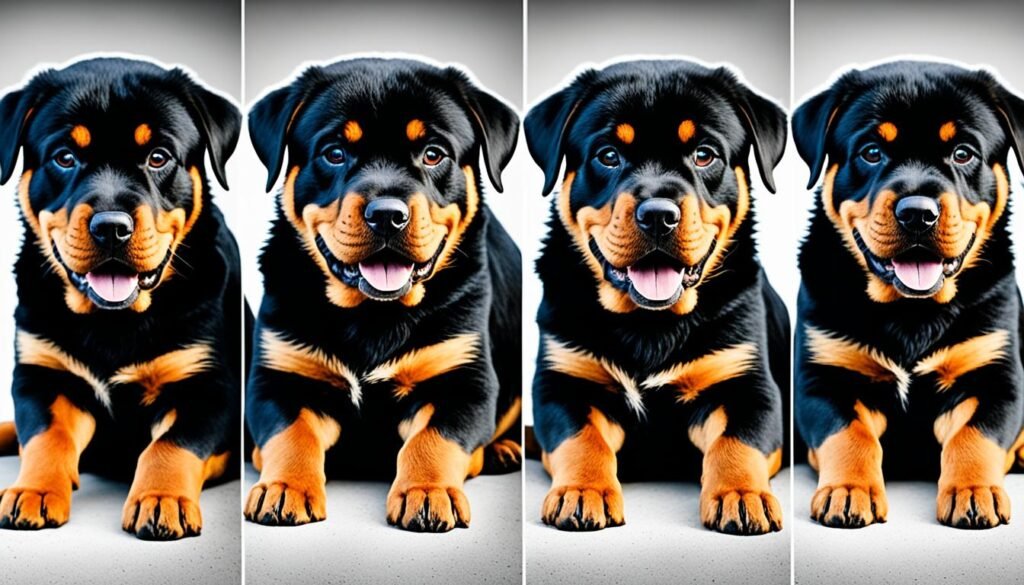Hey there, Rottweiler enthusiasts! Are you prepared to dive deep into the fascinating world of your beloved furry companions? Today, I’m going to share some valuable insights about the Rottweiler heat cycle, also known as the reproductive cycle. Understanding this natural process is essential for every responsible Rottweiler owner.
First things first, let’s talk about the frequency of the Rottweiler heat cycle. This breeding season occurs every 6 to 12 months, and it typically lasts for about 3 to 4 weeks. Knowing when your Rottweiler will enter into her heat cycle can help you better prepare for her needs and ensure her overall well-being.
During a Rottweiler’s heat, there are several signs to keep an eye out for. These include a swollen genital area, vulvar bleeding or discharge, increased frequency of urination, changes in tail placement, excessive genital licking, aggression or agitation, and receptivity to male dogs. It’s crucial to understand these signs to ensure you can provide the appropriate care and attention when needed.
Managing your Rottweiler’s heat cycle requires a proactive approach. To keep her safe and prevent unwanted pregnancies, it’s important to keep her away from intact male dogs for a duration of 3 to 4 weeks from the onset of bleeding. Providing a secure environment and using special clothing or diapers can help manage any discharge during this time.
Now, you might be wondering about the benefits of spaying your female Rottweiler. Spaying reduces the risk of mammary cancer and helps prevent complications such as pyometra, an infection of the uterus that can be life-threatening. However, if you are considering responsible breeding, consult with your veterinarian to determine the best timing for spaying.
Every Rottweiler’s journey is unique, and the age at which they experience their first heat can vary. It typically occurs between 6 and 15 months of age, with larger breeds, including Rottweilers, sometimes experiencing their first heat later, around 2 years old. Understanding their sexual maturity is crucial to providing the care they need.
Key Takeaways:
- The Rottweiler heat cycle occurs every 6 to 12 months and lasts for approximately 3 to 4 weeks.
- Signs of a Rottweiler in heat include a swollen genital area, vulvar bleeding or discharge, increased frequency of urination, and changes in behavior.
- Keeping your Rottweiler in a secure environment and managing any discharge with special clothing or diapers is key during her heat cycle.
- Spaying your female Rottweiler is highly recommended for her overall reproductive health and to prevent potential complications.
- The age at which a Rottweiler experiences her first heat can vary, typically occurring between 6 and 15 months of age.
Now that you’re equipped with a basic understanding of the Rottweiler heat cycle, you’ll be able to navigate this natural process with confidence and provide the best care for your furry friend. Stay tuned for more insightful information and tips on maintaining your Rottweiler’s reproductive health!
Frequency of Rottweiler's Heat Cycle
A Rottweiler’s heat cycle typically occurs twice a year. Each heat cycle can last for about 3 to 4 weeks. The duration of the heat cycle can vary among individual Rottweilers.
Rottweilers, like many other dog breeds, experience regular heat cycles as part of their reproductive cycle. Understanding the frequency and duration of these heat cycles is essential for responsible pet owners.
On average, Rottweilers go into heat twice a year. This means that approximately every six months, female Rottweilers will experience a heat cycle, which typically lasts for around 3 to 4 weeks. However, it’s important to note that individual Rottweilers may have slight variations in their heat cycle duration.
During this time, female Rottweilers may exhibit certain physical and behavioral changes, indicating their fertility. It is crucial to understand and monitor these changes to prevent unwanted pregnancies and ensure the well-being of your Rottweiler.
Now that we have explored the frequency of a Rottweiler’s heat cycle, let’s move on to the next section to discuss the signs that indicate a Rottweiler is in heat and their fertile period.
Signs of Rottweiler's Heat
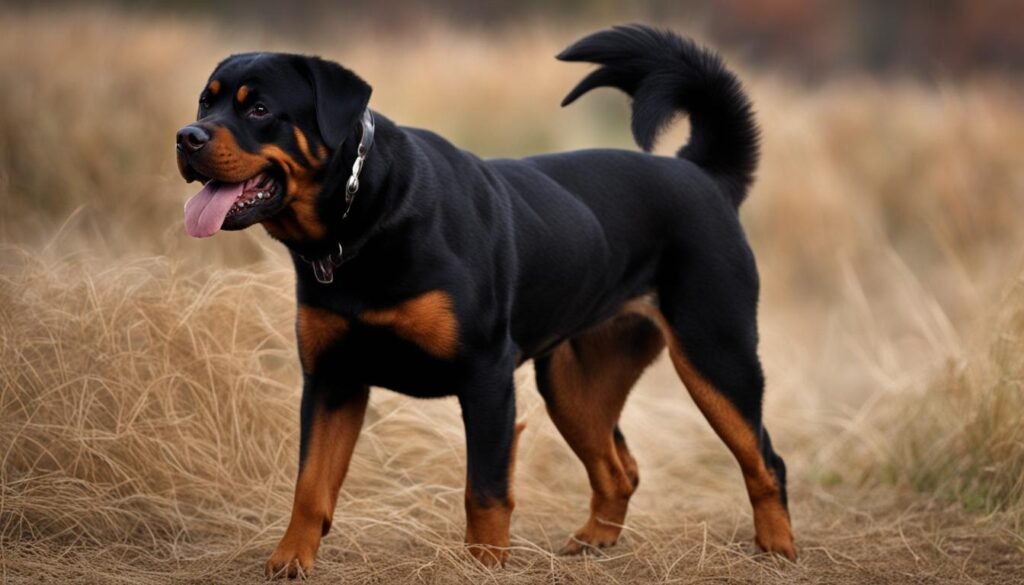
During a Rottweiler’s heat, there are several signs that can indicate her fertility and readiness to mate. It’s important for Rottweiler owners to be aware of these signs and understand their significance. Here are the key signs to look out for:
- A swollen genital area: The vulva becomes visibly swollen and enlarged, indicating that the Rottweiler is in heat.
- Vulvar bleeding or discharge: The female Rottweiler may have a bloody or clear discharge from her vulva, which is a strong indicator that she is in heat.
- Increased frequency of urination: Rottweilers in heat may urinate more frequently than usual.
- Changes in tail placement: The Rottweiler’s tail may be held to the side or raised, which is a sign of sexual receptivity.
- Excessive genital licking: A Rottweiler in heat may frequently lick her genital area as part of the natural heat cycle.
- Aggression or agitation: Some Rottweilers may become more aggressive or agitated during their heat cycle.
- Receptivity to male dogs: The female Rottweiler may display increased interest in male dogs, seeking their attention and allowing mating attempts.
The fertility period of a Rottweiler usually occurs around day 10-15 of her heat cycle. This is the time when she is most receptive to male dogs and has the highest chances of becoming pregnant. It’s important to monitor these signs closely and take appropriate precautions to prevent any unwanted or unplanned breeding.
Managing Rottweiler's Heat Cycle
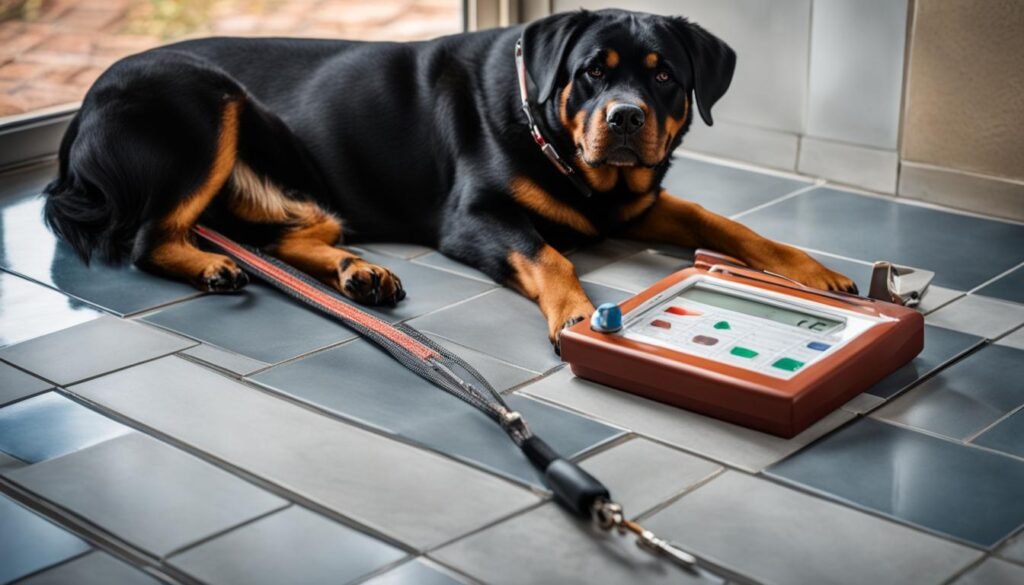
When your Rottweiler is in heat, it is important to take precautions to ensure her safety and comfort.
To prevent unwanted mating and escape attempts, I recommend keeping your Rottweiler in a secure location. This could be a designated area in your home or a secured outdoor enclosure. By providing a safe space, you can effectively manage her heat cycle and minimize the risk of accidental breeding.
When taking your Rottweiler outside, always use a leash to maintain control. Avoid areas with intact male dogs and dog parks, as this can reduce the chances of unwanted attention and potentially stressful encounters during this sensitive period.
During her heat cycle, your Rottweiler may experience changes in behavior and mood. To ease any stress or anxiety, provide her with extra affection, attention, and mental stimulation. Engage in playtime and exercise to help her release energy and maintain a sense of normalcy.
Managing the discharge that occurs during a Rottweiler’s heat cycle can be challenging. Consider using special diapers or clothing designed for this purpose. These can help keep your Rottweiler comfortable while minimizing any mess or discomfort.
Remember, each Rottweiler may have different needs and behaviors during their heat cycle. It is essential to observe your dog closely and provide appropriate care and attention based on her individual needs.
Spaying and Reproductive Health
Spaying your female Rottweiler is a crucial step in ensuring her reproductive health. Unless you plan on responsible breeding, spaying your Rottweiler offers numerous benefits and helps prevent potential health complications down the line.
One of the significant advantages of spaying your Rottweiler is the reduced risk of mammary cancer. Studies have shown that spaying before the first or second heat cycle significantly decreases the chances of developing mammary tumors, which can be both benign and malignant.
Moreover, spaying eliminates the risk of pyometra, a life-threatening infection of the uterus. Pyometra commonly occurs in unspayed female dogs and requires immediate veterinary intervention. By spaying your Rottweiler, you can prevent this potentially fatal condition and promote her overall well-being.
When considering the best time to spay your Rottweiler, consult with your veterinarian. It is generally recommended to spay before the first or second heat cycle. Your veterinarian will be able to provide personalized advice based on your Rottweiler’s specific needs and circumstances.
Benefits of spaying your Rottweiler:
- Reduced risk of mammary cancer.
- Prevention of pyometra.
- Elimination of the heat cycle and associated behaviors.
- Prevention of unplanned pregnancies and the burden of caring for a litter.
- Improved overall reproductive health and longevity.
By spaying your Rottweiler, you are taking a proactive step in ensuring her reproductive health and well-being. Consult with your veterinarian to determine the best course of action for your furry companion.
Age of First Heat and Maturity
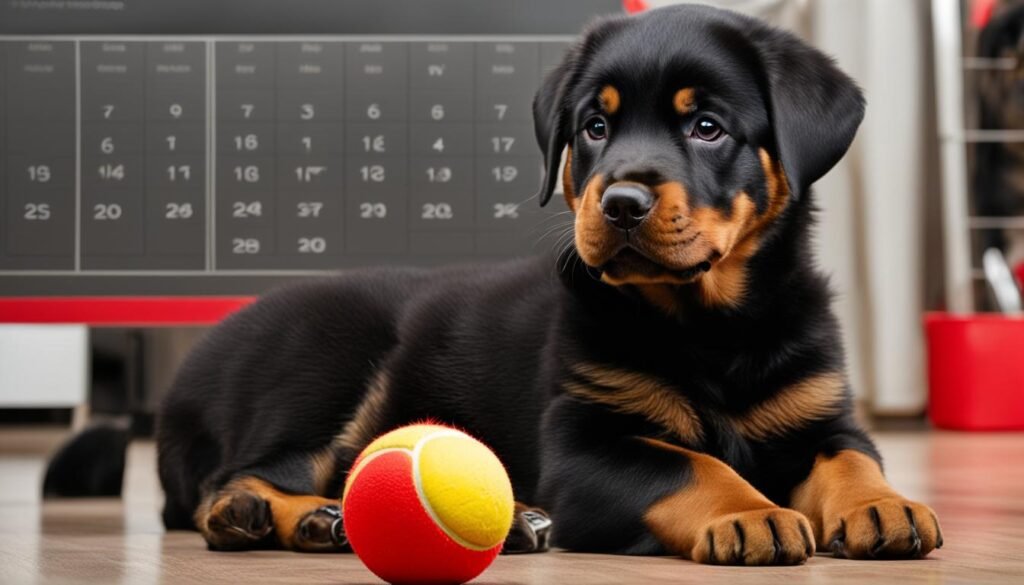
When it comes to the age at which a Rottweiler experiences her first heat, there is some variation. Typically, Rottweilers will go into heat between 6 and 15 months of age. However, larger or giant breeds may experience their first heat later, around 2 years of age. It’s important to note that Rottweilers reach sexual maturity after approximately 18 months.
During a Rottweiler’s first heat, her body undergoes significant hormonal changes as she prepares for reproduction. It’s crucial to closely monitor your Rottweiler during this time and take necessary precautions to prevent any unwanted pregnancies. Spaying your Rottweiler at the appropriate age can help maintain her reproductive health and prevent any potential complications.
To ensure the well-being of your Rottweiler, it’s essential to provide her with proper care and attention during her first heat and throughout her reproductive years. By understanding the age of her first heat and the stage of sexual maturity, you can help ensure a smooth and healthy transition into adulthood.
Remember, each Rottweiler is unique, and the timing of her first heat can vary. Consulting with your veterinarian and closely observing your Rottweiler’s behavior and physical changes can help you navigate her reproductive journey with care and confidence.
Different Phases of Rottweiler's Heat Cycle
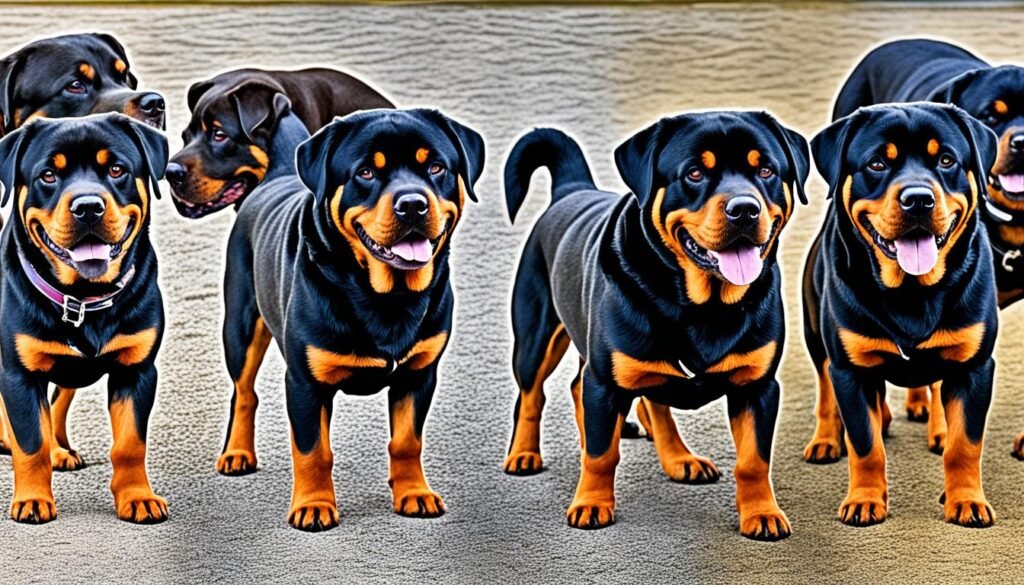
Understanding the different phases of a Rottweiler’s heat cycle is essential for responsible pet ownership. The Rottweiler’s heat cycle consists of four distinct phases: proestrus, estrus, diestrus, and anestrus. Let’s take a closer look at each phase:
- Proestrus: This is the beginning stage of the heat cycle, lasting for about 9 to 10 days. During this phase, the Rottweiler’s vulva swells, and there may be slight bleeding or discharge.
- Estrus: Also known as the mating phase, estrus follows proestrus and lasts for approximately 5 to 9 days. This is the period when the female Rottweiler is receptive to male advances and can potentially get pregnant.
- Diestrus: Diestrus is the post-mating phase, typically lasting for around 60 days. During diestrus, hormonal changes occur, and the female Rottweiler’s reproductive tract undergoes preparation for pregnancy. However, if the dog did not conceive, she will not show any further signs of heat.
- Anestrus: Anestrus is the resting phase, occurring between heat cycles. It typically lasts for several months, during which the Rottweiler’s reproductive system recovers before the next proestrus phase begins.
It’s crucial for dog owners to be aware of these phases and their respective durations. This knowledge will help determine the appropriate time for breeding or to take preventive measures to avoid unwanted pregnancies.
First Heat Cycles in Different Breeds
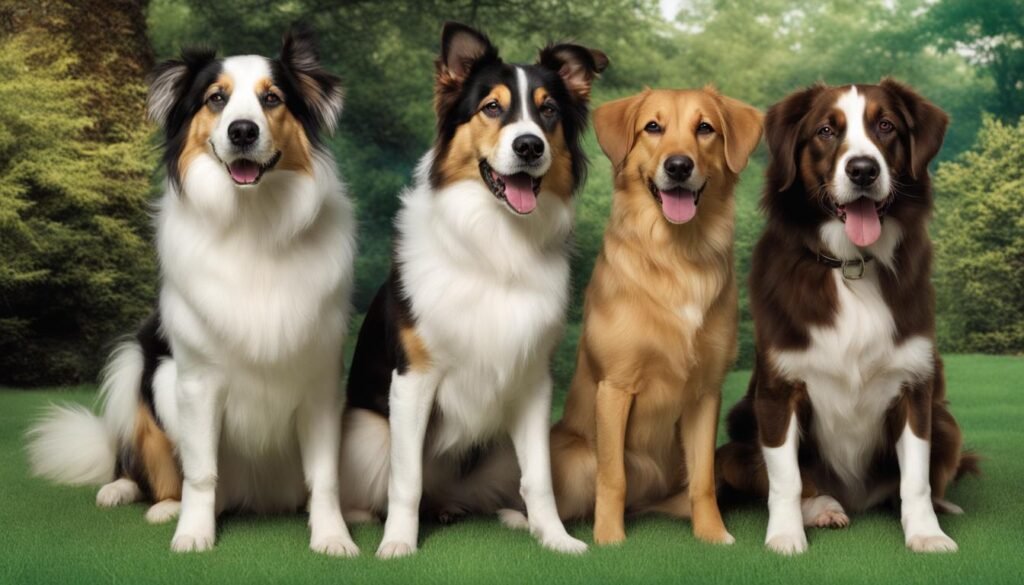
When it comes to the age at which different breeds experience their first heat, there can be significant variation. Toy breeds, such as Chihuahuas and Yorkshire Terriers, may go into their first heat as early as 4 months old. On the other hand, giant breeds like Great Danes and Saint Bernards may not experience their first heat until they are around 2 years old. For most dogs, however, their first heat typically occurs between 6 and 15 months of age.
The variation in the age of the first heat cycle among different breeds can be attributed to factors such as size, genetics, and individual development. Small breeds tend to reach sexual maturity earlier than larger breeds. Additionally, certain breeds may have specific hormonal patterns that influence the timing of their first heat.
To illustrate the range of ages at which different breeds experience their first heat, here are a few examples:
- Toy Breeds: Small breeds like Chihuahuas, Yorkshire Terriers, and Pomeranians may have their first heat as early as 4 to 6 months of age.
- Medium Breeds: Breeds like Cocker Spaniels, Beagles, and Australian Shepherds usually experience their first heat between 6 and 10 months of age.
- Large Breeds: Labrador Retrievers, Golden Retrievers, and Boxers often have their first heat around 9 to 15 months of age.
- Giant Breeds: Great Danes, Saint Bernards, and Mastiffs are known to have a delayed onset of their first heat, typically occurring when they are around 18 to 24 months old.
It’s important to remember that these age ranges are generalizations and individual dogs may deviate from them. If you’re unsure about when your specific breed is expected to have its first heat, consulting with a veterinarian can provide valuable insight.
Preventing Unwanted Pregnancy
To prevent unwanted pregnancy during a Rottweiler’s heat, it is important to take proactive measures to separate her from male dogs for a minimum of 3 to 4 weeks after the onset of bleeding. While the bleeding may eventually stop, it’s crucial to note that a female Rottweiler can still become pregnant during this time. Therefore, it is vital to maintain precautions and ensure that she remains away from intact males to avoid any unplanned litters.
During a Rottweiler’s heat cycle, her reproductive system becomes highly receptive to male dogs, increasing the risk of unintended breeding. To minimize this risk, it is essential to provide a secure and controlled environment for your female Rottweiler during her heat cycle. This includes keeping her away from areas where intact male dogs may be present, such as dog parks or areas with high canine traffic.
Furthermore, it is crucial to closely monitor your Rottweiler’s behavior and take note of any signs of interest or receptivity towards male dogs. If you own both a male and female Rottweiler, it is imperative to separate them during the female’s heat cycle to avoid any potential mating.
By actively preventing unwanted pregnancy and carefully managing your Rottweiler’s interactions with males during her heat cycle, you can help ensure that breeding occurs only when intended and that potential complications and challenges associated with unexpected litters are avoided.
Caring for Rottweilers in Heat
When it comes to caring for Rottweilers during their heat cycle, there are a few important considerations to keep in mind. Providing extra love and attention to your furry friend can go a long way in making them feel more comfortable during this time. Additionally, limiting their outdoor activities can help prevent any unwanted interactions with male dogs that may lead to pregnancy.
In managing any discharge that may occur, protective clothing or diapers designed for this purpose can be a helpful solution. These not only help keep your Rottweiler clean but also minimize the mess associated with the heat cycle.
It’s important to note that a Rottweiler in heat may experience personality changes. Some females may become more agitated or aggressive, while others may become more affectionate. Providing appropriate mental and physical stimulation can help alleviate any restlessness or anxiety they may be experiencing.
Taking care of your Rottweiler during their heat cycle is crucial for their overall well-being. By implementing these tips for managing a female Rottweiler’s heat, you can ensure they remain comfortable, safe, and happy during this natural phase of their reproductive cycle.
Keeping Your Rottweiler Safe During Heat
During your Rottweiler’s heat cycle, it is essential to prioritize their safety and take necessary precautions to prevent unwanted mating. By creating a secure and controlled environment, you can ensure your Rottweiler’s wellbeing and avoid any potential escape attempts or unplanned breedings.
When taking your Rottweiler outside, always keep them on a leash to maintain control and prevent interactions with intact male dogs. It is also advisable to avoid areas such as dog parks or public spaces where intact males may be present. Keeping a safe distance will minimize the risk of unwanted mating and maintain your Rottweiler’s safety.
If you have both a male and female Rottweiler in your care, it is crucial to separate them during the female’s heat cycle. This separation will prevent any unexpected breedings and ensure that you have full control over their reproductive activities.
Remember, the heat cycle can be a challenging time for your Rottweiler, so taking precautions to keep them safe is of utmost importance. By implementing these measures, you can prevent unwanted mating, maintain control over their interactions, and ultimately protect your Rottweiler’s reproductive health.
Conclusion
Understanding the frequency and duration of a Rottweiler’s heat cycle is essential for responsible pet owners. The heat cycle typically occurs every 6 to 12 months and lasts for approximately 3 to 4 weeks. During this time, it is crucial to be aware of the signs and symptoms of a Rottweiler in heat, such as a swollen genital area and vulvar bleeding or discharge.
To effectively manage a Rottweiler’s heat cycle, precautions should be taken to prevent unwanted mating and ensure the safety and comfort of the dog. Keeping the Rottweiler in a secure environment, using a leash when outside, and avoiding areas with intact male dogs are important measures to prevent accidental breedings. Additionally, providing extra love and attention, limiting strenuous activities, and using protective clothing or diapers can help manage any discharge and keep the Rottweiler comfortable throughout the heat cycle.
Spaying is highly recommended for the reproductive health of female Rottweilers. It reduces the risk of mammary cancer and eliminates the potential complications, such as pyometra, that can arise from an unspayed female. Consult with a veterinarian to determine the best timing for spaying your Rottweiler, typically before her first or second heat cycle.
By understanding and effectively managing a Rottweiler’s heat cycle, you can ensure the optimal reproductive health and overall well-being of your furry companion. Taking the necessary precautions and providing proper care during this time will help keep your Rottweiler happy and healthy for years to come.
FAQ
How often do Rottweilers go into heat?
A Rottweiler’s heat cycle typically occurs twice a year, every 6 to 12 months.
What is the average duration of a Rottweiler’s heat cycle?
Each heat cycle in a Rottweiler can last for about 3 to 4 weeks, but the duration may vary among individual dogs.
What are the signs of a Rottweiler’s heat?
Signs of a Rottweiler’s heat include swollen genital area, vulvar bleeding or discharge, increased urination, changes in tail placement, excessive genital licking, aggression or agitation, and receptivity to male dogs.
How long is a Rottweiler’s fertility period?
The female Rottweiler is most fertile around day 10-15 of her heat cycle.
How should I manage my Rottweiler’s heat cycle?
During your Rottweiler’s heat, keep her in a secure location, use a leash outside, avoid dog parks or areas with intact male dogs, and provide extra affection and activities to reduce stress. You can also consider using special diapers or clothing to manage any discharge and be prepared for personality changes.
Should I spay my female Rottweiler?
Spaying is highly recommended unless you plan on responsible breeding. It reduces the risk of mammary cancer and avoids complications like pyometra. It is typically recommended to spay a Rottweiler before her first or second heat cycle.
At what age do Rottweilers experience their first heat?
The age at which a Rottweiler experiences her first heat can vary, typically occurring between 6 and 15 months of age. Large or giant breeds may experience their first heat later, around 2 years of age.
What are the different phases of a Rottweiler’s heat cycle?
The Rottweiler’s heat cycle consists of four phases: proestrus, estrus, diestrus, and anestrus. Proestrus is the start of the heat period where the vulva swells and bleeding may occur. Estrus is the mating phase where the female is receptive to male advances. Diestrus follows the mating phase and lasts for about two months. Anestrus is the uterine repair phase that occurs before the next proestrus stage begins.
At what age do different breeds experience their first heat?
The age at which different breeds experience their first heat can vary. Toy breeds may experience their first heat as early as 4 months old, while giant breeds may wait until they are 2 years old. Most dogs have their first heat between 6 and 15 months of age.
How do I prevent unwanted pregnancy during my Rottweiler’s heat?
To prevent unwanted pregnancy during a Rottweiler’s heat, keep her separated from male dogs for at least 3 to 4 weeks after the first sign of bleeding. Remember that a female dog can still get pregnant even after the bleeding stops.
How should I care for my Rottweiler during her heat?
When your Rottweiler is in heat, provide extra love and attention, limit outdoor activities, and consider using protective clothing or diapers to manage any discharge. Be aware of personality changes and provide appropriate mental and physical stimulation.
How can I keep my Rottweiler safe during her heat?
Keep your female Rottweiler in a secure and controlled environment during her heat cycle to prevent unwanted mating and potential escape attempts. Keep her on a leash when outside and avoid areas with intact male dogs. If you have a male and female Rottweiler, separate them to avoid any unexpected breedings.
